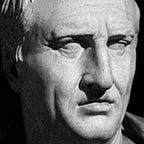Hurricane Truth
How to think the unthinkable.
Truth is like the eye of a hurricane. I mean this as an analogy not a simile. My intention isn’t lyrical, but technical. Like the eye of a hurricane, truth does not exist in a positive sense. The eye is an effect of forces around it rather than a thing-in-itself, though its wall appears to be completely present, if not super-material — harder than the hardest things.
A hurricane is only wind, nothingness, but it can flatten your house.
The first stage of philosophy is realism with regard to truth. The truth is out there and does not change, whether it is given by God or nature.
The second stage is relativism. Truth is man-made and conventional. It can change.
The third stage of philosophy — which occupies most of what deserves the name — is concerned with the problem of how truth can be both real and relative. This problem is usually solved by dividing truths hierarchically or temporally.
In the first case, some truths — usually mathematical and logical truths — are considered to be absolutely true, while others — moral truths — are thought to be only locally, relatively true. These are truths, not “truth.” Now that we (mostly) don’t believe that God dictates moral truth along with mathematical truth, this is a common view.
When divided temporally, on the other hand, truth evolves over time, so at one point in time there is consensus that geocentrism is true, followed by a point in time in which the consensus is that geocentrism is false. Philosophers from Hegel to Kuhn have tried to give accounts that make sense of this. It’s hard to make sense of because a) the earlier point in time is visible from the later point in time and b) it is very hard for humans to think this way.
Why is it so hard? It’s hard, it seems, because even if our ideas of truth are contingent — tied to time and imperfect knowledge — our minds really do not want them to be. Buddhists believe that there is no self, but this idea does not come naturally. It is difficult to cultivate. Same with the idea that truth is not absolute.
The American pragmatists tried to tackle this in the wake of the Civil War, after — according to Louis Menand’s gloss in The Metaphysical Club — William James saw what terrible violence belief could inspire. Richard Rorty followed this train of thought when he introduced his liberal ironist, a subject who fights for truths — a “final vocabulary” — she cannot justify.
But how to think like this?
Think of the hurricane. Social forces are in motion and have been in motion since the beginning of history. At any given time there are beliefs that are so widely held that they do not seem like wind, but like a wall. At the eye of the hurricane are the beliefs that everyone takes to be true, but as you move to the periphery you move through the levels of arguable, debatable, far-fetched, scandalous, and — ultimately — taboo. But the hurricane is constantly in motion, bringing some things to the eye and sending others out to the periphery.
For most of human history, the eye has been too strong — more wall than not — save for moments of upheaval: the 1780s, the 1910s, the 1960s. The eye has never been so weak in my lifetime. The barometry is at once bracing and terrifying.
